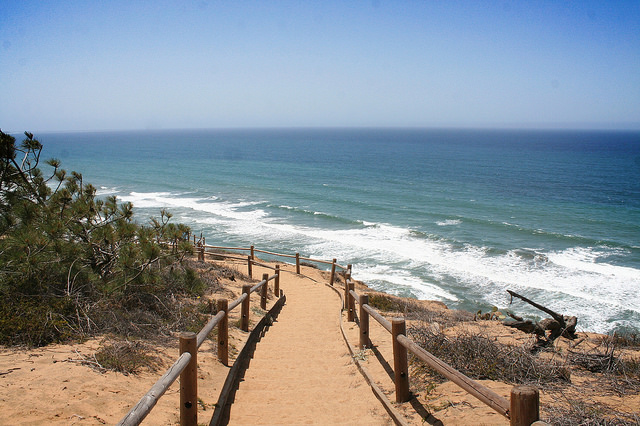Native Americans
Long before Europeans arrived, the Torrey Pines area was home to the Kumeyaay.
Their lands extended from the Pacific Ocean south to what is now Ensenada, Mexico, east to the sand dunes of the Colorado River in the Imperial Valley, and north through the Warner Springs Valley, to what is now Oceanside and Highway 78.
These lands were linked together by vast trading networks.
Living in bands of extended families, the Kumeyaay traveled the coast, mountains, and desert foothills. They spoke several dialects - the "Ipai" here in the north, and the "Tipai" in the south.
Their shelters and shade ramadas were constructed from local plants, which included willow, oak, manzanita, deerweed, tule, and chamise.
Naming of the Torrey Pine
Because groves of trees were not common along the Southern California coast, early Spanish explorers (1500-1700 AD) referred to this area as Punto de Los Arboles, which literally means "Point of Trees."
They used this area both as a landmark and as a warning that they were too close to the shore in the fog.
In 1769, the Portola-Serra Sacred Expedition passed through nearby Sorrento Valley on its way from San Diego to colonize Monterey and establish missions along the way.
The trail they used is referred to as El Camino Real. The trees themselves were referred to as Soledad Pines (Solitary Pines) by the first non-Native Americans to visit the area. The name remained until 1850.
Protecting the Pines
In 1883, Parry re-visited the area. Surprised at the lack of protection for the trees, he wrote a historical and scientific account of the pine emphasizing the need to protect the tree from extermination. This was presented to the San Diego Society of Natural History.
The first source of protection came in 1885 from the San Diego County Board of Supervisors. They posted signs citing a reward of $100 for the apprehension of anyone vandalizing a Torrey pine tree.
Establishment of Park
Persuaded by city father George Marston, botanists David Cleveland and Belie Angler, the City Council in 1899 passed an ordinance to set aside 364 acres of pueblo lands as a public park. Unfortunately, the ordinance made no provisions for protecting the tree.
After the turn of the century, the lands surrounding the park were in danger of being commercially sold. Between 1908 and 1911, newspaper woman and philanthropist, Ellen Browning Scripps, acquired two additional pueblo lots and willed them to the people of San Diego.
This added to the park the area of North Grove and the estuary.
By the time she died in 1932, Miss Scripps had contributed greatly not only to the establishment of our park, but also to the Natural History Museum, Scripps Institution of Oceanography, the Zoo, the La Jolla Childrens' Pool, and the Scripps Clinic and Research facility.

